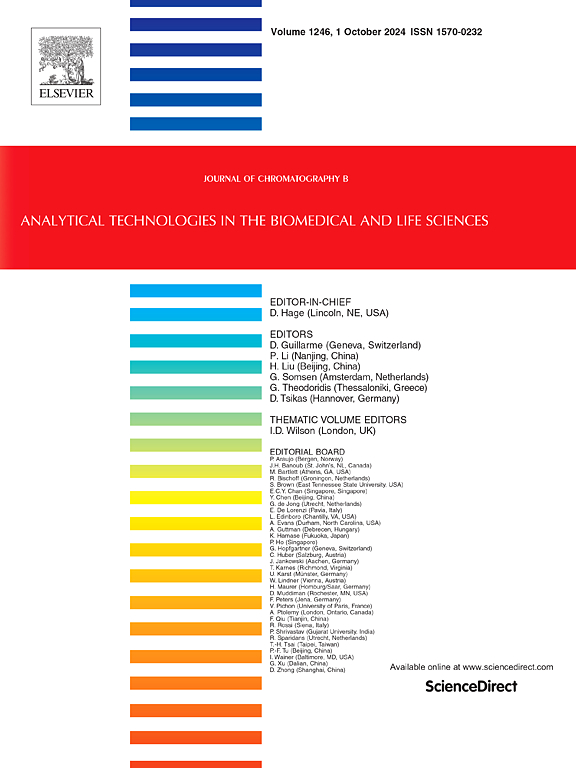Improved column chromatography–thin layer chromatography densitometry method for purification of dairy sphingomyelin
IF 2.8
3区 医学
Q2 BIOCHEMICAL RESEARCH METHODS
引用次数: 0
Abstract
Sphingomyelin (SM) has the potential to be widely used in the food, cosmetics and pharmaceutical industries. However, SM is found in trace amounts in substances such as egg yolk and dairy products. Traditional purification methods, such as solvent extraction and column chromatography, have several drawbacks, including low purity, high loss and high solvent consumption, as well as complicated operation. These factors make efficiently separating high-purity SM difficult. In this work, a gradient elution silica gel column chromatography method dynamically monitored by TLC was developed for the purification of SM from milk phospholipid (MPL). First, the TLC elution conditions were optimized as follows: solvent methyl acetate–isopropanol–chloroform–methanol-0.25 % (w/v) potassium chloride (25:25:25:10:9, v/v/v/v/v/v), spot volume of 50–75 μg MPL or 5–7.5 μg SM sample, separation distance of 16 cm and 25 °C. Then, the relative quantification of SM was performed in combination with ImageJ software, and the method was confirmed to be accurate and reliable through a comprehensive evaluation of its precision, accuracy, LOD and LOQ. Finally, the optimized silica gel column chromatography method was used for the purification of SM by TLC dynamic monitoring, and the methyl acetate–isopropanol–dichloromethane–methanol–water system (25:25:25:10:11, v/v/v/v/v) was used as the first eluent, and the dichloromethane–methanol–water system (45:30:8.5, v/v/v) was used as the second eluent. SM recoveries exceeded 85 % under the optimal conditions of silica gel sample volumes of 3.125–3.75 mg/g and a diameter-to-height ratio of 1:5–1:6. The purity of SM prepared by the above method reached 90 % (molar ratio) as determined by 31P NMR, and SM had a higher percentage of esterified long chain saturated fatty acids (more than 20 carbon atoms) as determined by UPLC-MS/MS.
改进柱层析-薄层析密度法纯化乳鞘磷脂
鞘磷脂(SM)在食品、化妆品和制药等领域具有广泛的应用前景。然而,在蛋黄和乳制品等物质中发现了微量的SM。传统的提纯方法,如溶剂萃取、柱层析等,存在纯度低、损失高、溶剂消耗大、操作复杂等缺点。这些因素使高效分离高纯度SM变得困难。本文建立了一种TLC动态监测的梯度洗脱硅胶柱层析法,用于从牛奶磷脂(MPL)中分离SM。首先,优化TLC洗脱条件为:溶剂乙酸甲酯-异丙醇-氯仿-甲醇- 0.25% (w/v)氯化钾(25:25:25:10:9,v/v/v/v/v/v),斑点体积为50-75 μg MPL或5-7.5 μg SM样品,分离距离为16 cm, 25°C。然后结合ImageJ软件对SM进行相对定量,通过对其精密度、准确度、LOD和LOQ进行综合评价,证实该方法准确可靠。最后,采用优化后的硅胶柱层析法对SM进行TLC动态监测纯化,以乙酸甲酯-异丙醇-二氯甲烷-甲醇-水体系(25:25:25:10:11,v/v/v/v/v)为第一洗脱液,以二氯甲烷-甲醇-水体系(45:30:8.5,v/v/v)为第二洗脱液。在硅胶样品体积为3.125 ~ 3.75 mg/g、径高比为1:5 ~ 1:6的最佳条件下,SM的回收率超过85%。经31P NMR测定,该方法制备的SM纯度达到90%(摩尔比),UPLC-MS/MS测定,SM具有较高的酯化长链饱和脂肪酸(超过20个碳原子)百分比。
本文章由计算机程序翻译,如有差异,请以英文原文为准。
求助全文
约1分钟内获得全文
求助全文
来源期刊

Journal of Chromatography B
医学-分析化学
CiteScore
5.60
自引率
3.30%
发文量
306
审稿时长
44 days
期刊介绍:
The Journal of Chromatography B publishes papers on developments in separation science relevant to biology and biomedical research including both fundamental advances and applications. Analytical techniques which may be considered include the various facets of chromatography, electrophoresis and related methods, affinity and immunoaffinity-based methodologies, hyphenated and other multi-dimensional techniques, and microanalytical approaches. The journal also considers articles reporting developments in sample preparation, detection techniques including mass spectrometry, and data handling and analysis.
Developments related to preparative separations for the isolation and purification of components of biological systems may be published, including chromatographic and electrophoretic methods, affinity separations, field flow fractionation and other preparative approaches.
Applications to the analysis of biological systems and samples will be considered when the analytical science contains a significant element of novelty, e.g. a new approach to the separation of a compound, novel combination of analytical techniques, or significantly improved analytical performance.
 求助内容:
求助内容: 应助结果提醒方式:
应助结果提醒方式:


